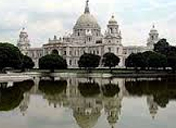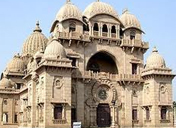ABOUT US
About NSCBIA
Kolkata New Airport Terminal – Gateway of Eastern India
 Kolkata–The City of Joy: India's one of the largest metro city and once the capital (1772-1912) of British India, Kolkata is located on the east bank of the Hooghly, a channel of the Ganges, 154 km upstream from the Bay of Bengal. Growing beyond its British colonial foundations, Kolkata assimilated strong European influences to create an amalgam culture that found early expression in the life and works of the 19th-century Bengali elite and its best known personality, Rabindranath Tagore. Kolkatans are said to possess a rare joie de vivre that manifests itself in their penchant for art and culture and a level of intellectual vitality and politico.
Kolkata–The City of Joy: India's one of the largest metro city and once the capital (1772-1912) of British India, Kolkata is located on the east bank of the Hooghly, a channel of the Ganges, 154 km upstream from the Bay of Bengal. Growing beyond its British colonial foundations, Kolkata assimilated strong European influences to create an amalgam culture that found early expression in the life and works of the 19th-century Bengali elite and its best known personality, Rabindranath Tagore. Kolkatans are said to possess a rare joie de vivre that manifests itself in their penchant for art and culture and a level of intellectual vitality and politico.
Kolkata Airport, widely known as Netaji Subhash Chandra Bose International Airport, renamed in the honor of Subhas Chandra Bose a great freedom fighter, is located in Dum Dum area approximately 5 Km from newly developing industrial IT hub and 17 km from centre city. It is the fifth busiest airport in the country after Mumbai, Delhi, Chennai and Bangalore and presently handling over 9.0 million passengers annually. The airport is the largest in eastern India and the only international airport operating in West Bengal with huge prospects of becoming an aviation hub of this region. With the realization that the current terminal have already saturated and would not be able to handle the influx of passengers due to massive growth in passenger volume during the past three to four years, Airports Authority of India has planned and taken up construction of a new integrated airport passenger terminal with a capacity of 20 Million Pax per annum with a floor carpet area of more than 2,00,000 sq meters.
New Airport Terminal – A Jewel in Crown: Over the years, the city of Kolkata skyline has continually evolved as higher and more prominent buildings have taken shape in this fast developing financial city of modern India and gateway to Eastern India in recent years. Owing to city development and air-traffic growth in recent years, Airports Authority of India has taken up large scale airport development plans including a new state-of-art integrated airport terminal as a land mark in city to rival other beaming airports in this region of Asia pacific. This modern excellent glass-steel structure is being constructed using green building concept, environment friendly technology and world class passenger facilities. New terminal shall be ready to serve its customers by 1st quarter of 2012. Airports Authority of India appointed an international Architectural Design consultant for the designing of this new airport terminal with an emphasis on to derive operational synergy and optimum utilization of available resources by developing an integrated terminal building and a New York based Project Management consultant, Parsons Brinkerhoff, to supervise and monitor the construction of the state-of-art terminal building.
plans including a new state-of-art integrated airport terminal as a land mark in city to rival other beaming airports in this region of Asia pacific. This modern excellent glass-steel structure is being constructed using green building concept, environment friendly technology and world class passenger facilities. New terminal shall be ready to serve its customers by 1st quarter of 2012. Airports Authority of India appointed an international Architectural Design consultant for the designing of this new airport terminal with an emphasis on to derive operational synergy and optimum utilization of available resources by developing an integrated terminal building and a New York based Project Management consultant, Parsons Brinkerhoff, to supervise and monitor the construction of the state-of-art terminal building.
About the new Airport Terminal Project:
 The work on the new integrated terminal has already started in November 2008.The new integrated terminal will be an wide V-shaped structure with two-tiers operations for arrivals and departures. Once completed, the total capacity of the airport will be increased to 20 million passengers per annum to accommodate a peak flow of 1,800 passengers per hour. The new terminal building will have 104 check-in counters, 44 immigration counters, 24 security gates, seven check-in conveyor belts islands with in-line X-BIS sorter systems, 16 nos of arrival carousels, 27 elevators, 16 escalators, 13 travelators and 18 aerobridges etc. Design for the Kolkata Airport reflects the AAI’s vision for a world-class terminal that incorporates cutting-edge technology with the cultural stamp of a region in history and arts. The building is perceived as a single spacious volume, through which passengers can easily flow from the roadway to the aircraft. The building’s interiors emanate a sense of calm, uncluttered spaces and a landscaped courtyard at the heart of the building that offer a place for passengers to relax, away from the stress of their long journeys.
The work on the new integrated terminal has already started in November 2008.The new integrated terminal will be an wide V-shaped structure with two-tiers operations for arrivals and departures. Once completed, the total capacity of the airport will be increased to 20 million passengers per annum to accommodate a peak flow of 1,800 passengers per hour. The new terminal building will have 104 check-in counters, 44 immigration counters, 24 security gates, seven check-in conveyor belts islands with in-line X-BIS sorter systems, 16 nos of arrival carousels, 27 elevators, 16 escalators, 13 travelators and 18 aerobridges etc. Design for the Kolkata Airport reflects the AAI’s vision for a world-class terminal that incorporates cutting-edge technology with the cultural stamp of a region in history and arts. The building is perceived as a single spacious volume, through which passengers can easily flow from the roadway to the aircraft. The building’s interiors emanate a sense of calm, uncluttered spaces and a landscaped courtyard at the heart of the building that offer a place for passengers to relax, away from the stress of their long journeys.
The landscape concept and under roofing designs for the airport terminal is rooted in the rich cultural heritage of Kolkata and Bengal. It is conceived as one of the biggest piece of land art inspired by works of literary giant Rabindranath Tagore. The land art connects the building with its environment, the outside with the inside and creates a unique landscape. It also offers two disparate spatial experiences – the vastness of the grand central garden and the intimacy of the internal courtyards.
 The grand central garden is a canvas inspired by paintings and poems by Tagore, inspired by letters and words extracted from one of his famous poem ‘Gitanjali’, it becomes an art form for people to enjoy. Design conceived by RMJM, a Hong Kong based Architect & Lead Design consultant in association with STRATA, the leading landscape architects, the new Terminal is a five-tier building, with the bottom floor being the arrivals and upper arrival area and the top being a departures & upper departure area with basement for MEP services.
The grand central garden is a canvas inspired by paintings and poems by Tagore, inspired by letters and words extracted from one of his famous poem ‘Gitanjali’, it becomes an art form for people to enjoy. Design conceived by RMJM, a Hong Kong based Architect & Lead Design consultant in association with STRATA, the leading landscape architects, the new Terminal is a five-tier building, with the bottom floor being the arrivals and upper arrival area and the top being a departures & upper departure area with basement for MEP services.
 The environmentally responsive canopy design consists of the setback of the double-wall system of the canopy, which is an effective measurement for controlling the direct solar heat gain. The results of the thermal dynamics studies showing the combination of the natural buoyancy driven and mechanically driven ventilation cavities are an effective strategy for energy efficiency design. North facing roof lights and a central courtyard floods the interior with natural light. The roof is designed to harvest rainwater, which is stored and reused for both irrigation and washrooms. Uniting these design elements is the roof of the structure designed to resemble a shimmering piece of silk.
The environmentally responsive canopy design consists of the setback of the double-wall system of the canopy, which is an effective measurement for controlling the direct solar heat gain. The results of the thermal dynamics studies showing the combination of the natural buoyancy driven and mechanically driven ventilation cavities are an effective strategy for energy efficiency design. North facing roof lights and a central courtyard floods the interior with natural light. The roof is designed to harvest rainwater, which is stored and reused for both irrigation and washrooms. Uniting these design elements is the roof of the structure designed to resemble a shimmering piece of silk.
Air-side Interface: The integrated passenger terminal will have an apron for parking aircraft on its northern and north-eastern sides. Eighteen aircraft are proposed to be parked in in-contact configuration. These stands will supplement to other 53 aircraft parking bays. Passengers will be able to embark or disembark from any aircraft stand and shall be able to proceed to either domestic or international functions.

 City-side Interface: The approach road from the city shall be of an uni-directional 4 lane Approach Road merging with the existing road network without disrupting the vehicular flow to various other airport facilities. The proposed five level terminal is to be served by an elevated roadway leading to the departure facilities. The city side shall also be linked with the upcoming metro-rail connectivity from main city.
City-side Interface: The approach road from the city shall be of an uni-directional 4 lane Approach Road merging with the existing road network without disrupting the vehicular flow to various other airport facilities. The proposed five level terminal is to be served by an elevated roadway leading to the departure facilities. The city side shall also be linked with the upcoming metro-rail connectivity from main city.
Structural Design: In general, the structure has five levels, one basement at -7.3m/-5.3m accommodating baggage handling and other MEP services, ground level at +0.0m level arrival lounge for pax arrival & baggage claim, +4.5m level for operational offices and pax facilities, third floor at +9.5m level is for check-in and departure and + 13.0 level has airline lounges and pax facilities. The roof is a 3-dimensional steel trussed space structure varying in height and configuration from level +21.5m to a maximum of 31.65m. Foundation is bored cast in-situ piles of dia 600mm to 1000mm with depth varying from 16m to 40m. The lens roof trusses have trapezium cross section with a maximum depth of 4.5m at its mid-span. The profile of the curve has been designed to also provide sufficient depth over the supports to resist the cantilever forces with clear spans of trusses vary from 72m to 90m based on their location in plan.

| Salient Features of Terminal | ||||||||||||||||||||||||||||||||||||||||||||||||||||||
|
Structural Configuration of the Terminal building consists of pile foundation -8215 nos; concrete - 205123 Cum; Reinforcement Steel - 44,700 MT; Structural Steel - 11,000 MT and Roofing - 97,358 m2 with intelligent power supply management system at 11000Volt grid generation power back-up with building management system IT network.
Other Developments: Owing to a holistic development of Kolkata airport the following works are also being planned:
- Up-gradation of CNS/ATM systems
- State-of art Air Traffic Control tower and Technical building
- Metro-Rail connectivity from center city to airport with city check-in facilities.
- NEW INTEGRATED TERMINAL BUILDING WAS INAUGURATED BY PRESIDENT OF INDIA ON 20TH JANUARY 2013.
- THE NEW TERMINAL WAS OPERATIONALISED ON 10TH MARCH 2013.

Know Kolkata
-
Kolkata Hotels
Hotels Near Airport
-
Kolkata Nights
Clubs Near Airport
-
Kolkata Hotspots
Tourist Spots Near Kolkata
-
Kolkata Spirituals
Religious Spots
-
Kolkata Food
River Cruise In Ganges


